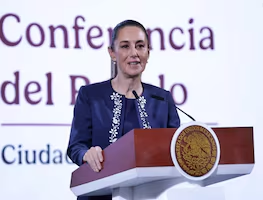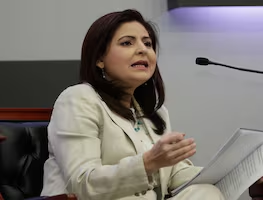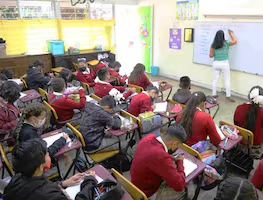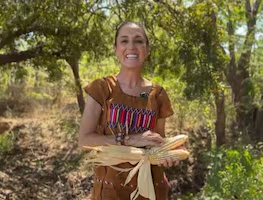Más Información

Claudia Sheinbaum, por definir asistencia presencial a reunión "urgente" de la Celac; migración, tema clave del encuentro

Noroña califica política de EU como hipócrita, racista y fascista; se solidariza con Petro ante deportaciones

Magistrada Mónica Soto propone sustituir al Comité de Evaluación del PJ; plantea someter a insaculación a aspirantes elegibles

Magistrado Reyes Rodríguez propone validar registros de aspirantes con promedio inferior a 8; excluirlos es “estigmatizante”, señala

¿Eres madre trabajadora? Puedes acceder a las guarderías del IMSS; descubre los requisitos y cómo hacerlo
30 years ago
, Mexico was living its first days with an Internet connection. Few people knew about it and even fewer knew it was thanks to the perseverance of a woman. It was Gloria Koenigsberger, an astrophysicist who noticed during the 1980s that it was necessary to decentralize science in Mexico. Gloria works on stellar astrophysics, that is, she studies the characteristics and physical processes of stars. She is a researcher of the Institute of Physical Sciences of the National Autonomous University of Mexico (UNAM) and published the book The Beginning of the Internet in Mexico in 2014.
“This first message is a small step for us and a big step for the University” were the first words Mexico sent the first time the nation connected to the Internet .
Did you know
?
Koenigsberger
says that in 1989 , most researchers lived in Mexico City and the metropolitan area. There had been efforts to decentralize science but to little success. “One of the most serious problems was the terrible communications infrastructure , both roads and telephones; scientists in other states were isolated from the capital and the rest of the world” according to the astrophysicist.

The Internet contributed to solving the needs of those researchers. In the case of the Astronomy Institute of UNAM , a great part of the researchers was in Ensenada, Baja California operating the San Pedro Mártir National Astronomic Observatory . Once the first connections to the Ensenada-Cuernavaca-CiudadUniversitaria-Boulder satellite network were installed in 1989, they started to connect to other public education institutions through UNAM. “It was almost instantly that we were able to exchange documents with articles, to access databases around the world, to do a remote login in computers located in other cities or countries, and of course, we started to use the e-mail to send messages and to have efficient communication.”
The first Internet connection was between the Astronomy Institute and the city of Boulder, Colorado in th e United States because they were the ones who had computers and a cleared need to connect their different venues and, eventually, the Observatory. Additionally, they wanted to have access to the astronomical data they had gathered during their work stays at NASA. For its part, the U.S. ad problems to connect all universities by cables, so the National Science Foundation funded many of them with stations like the one in Mexico. The operations center of this satellite network in the U.S. was located in the National Center for Atmospheric Science in Boulder, under the direction of Joseph Choy , that is why communications with Mexico were established there.
Have you heard of the
?
The process to connect Mexico to the Internet was very long. It started at the Communications and Transport Ministry . Back then, there was a network called “TELEPAC” but it was very limited. It took three years to obtain a connection “I said ‘Yes! Three years!’ Compare it to what it takes us now to connect to the web,” Koenigsberger says. Then, they contacted private networks in the U.S. to know if they could provide the service. Finally, they talked with contacts in the Astronomy world: in the National Observatory of Kitt Peak , Arizona , NASA’s International Ultraviolet Explorer Observatory , the Space Telescope Institute in Baltimore. “They guided us until we talked to Steve Wolf, who was in charge of starting NSFNet in the National Science Foundation” as explains the researcher.
Almost 20 years had passed since Leonard Kleinrock was able to send the message “Lo” from a machine in the UCLA to another one at Stanford , connected by cables. In 1989 , since telephone lines were in terrible conditions in Mexico, the only feasible technology was satellites. UNAM purchased three earth stations and installed them in Ciudad Universitaria, Ensenada, and Cuernavaca. Each one consisted of a satellite dish, a transmitter, and a receiver, connected to a computer. “The condition to be part of the NSFNet was for all the computers to use TCP/IP as a common language. The National Science Foundation and NASA shared the cost of the earth station located in Boulder. These equipment interconnected through the Morelos I and II satellites Mexico had purchased in 1985.”
How did other education institutes in Mexico connect to the Internet? “Many of them used microwave equipment ; they used command lines , that is, they typed commands. One of the first interfaces to access the Internet without typing commands as we currently do, was Mosaic , invented in 1993, followed by Netscape in 1994,” mentions Koenigsberger.
Did you know
?
The first Internet connection in Mexico took place on July 20, 1989 , 20 years after humanity reached the Moon. Susana Biro, Marco Ambriz, and Adriana Marroquín are accountable for the first message sent from Mexico through the web. They configured the computer and the router in the Astronomy Institute in Ciudad Universitaria to establish the first connection, and they were who sent the message in a Neil Armstrong style to Joseph Choy in Boulder, Colorado.

Once the first connection was achieved, Gloria Koenigsberger’s expectations as a scientist were to establish communication and transfer great amounts of data between national scientific centers to open collaboration opportunities between Mexican and foreign scientists, “It would allow us to use extraordinarily specialized and expensive equipment. For example, several of my colleagues, such as José Franco and Luis Aguilar, who used supercomputers in the United States and Germany, could have access to them without traveling to those countries; Luis Felipe Rodríguez , who used the VLA radiotelescope in New Mexico, could program his observations and bring the data directly to his office.”
Out of the academy, the Internet also helped Mexico in terms of access to information , technological modernization in telecommunications as well as in services. However, there is currently a negative side to the Internet. Some use social networks to offend, spread fake news, and to try to commit frauds, “I believe that the only way to fight these negative aspects [of the Internet] are through education and cutting-edge technology. We must convince users to have an open-minded, critical, and careful mentality to defend themselves from cyberattacks. ”
Consulting company The Competitive Intelligence Unit calculates that there are 86.6 million surfers in Mexico, regarding the current reach of the Inter, Gloria Koenigsberger says that “the Internet to which we connected in 1989 was exclusively to transmit scientific and academic information; it was forbidden to use it for any commercial purpose. Nowadays it is quite the opposite. I would have never imagined today’s Internet,” concludes the UNAM astrophysicist.
Did you know
?
mp





